kottke.org posts about books
In the November issue of Elle, Laurie Abraham talks about the fear, pressure, regret, and misconceptions related to how we think about abortion in America, written through the lens of her own experiences.
In several meetings at work in which this essay was discussed, I noticed that none of the other editors in the room, all of them pro-choice, could bring themselves to utter the word abortion; it was “Laurie’s pro piece,” or her “memoir.” I know that my colleagues, many of whom are my friends, were just trying to be kind when they referred to my “reproductive rights” story. The truth is, I felt uncomfortable saying it out loud too. Abortion is a conversational third rail, women’s dirtiest dirty laundry, to mix metaphors. Because the other thing about living in a political culture where a single-cell zygote is constantly being called a “person” is that there is a penumbra of shame surrounding abortion. For myself, however, I wonder: Am I really ashamed — and, if so, what is it exactly that I’m ashamed of?
The book Abraham references throughout, Katha Pollitt’s Pro: Reclaiming Abortion Rights sounds really interesting. (via @atotalmonet)

As I’ve written before, after the World Cup in 2010, I wanted to keep watching soccer but didn’t quite know how club soccer worked or anything about the various teams. I wish I’d had this book then: Club Soccer 101. It’s a guide to 101 of the most well-known teams from leagues all over the world.
The book covers the history of European powerhouses like Arsenal, Barcelona, Bayern Munich, Chelsea, Inter Milan, Manchester United, Paris Saint-Germain, and Real Madrid; historic South American clubs like Boca Juniors, Corinthians, Penarol, and Santos; and rising clubs from Africa, Asia, and America, including such leading MLS clubs as LA Galaxy, New York Red Bulls, and Seattle Sounders. Writing with the passion and panache of a deeply knowledgeable and opinionated fan, Luke Dempsey explains what makes each club distinctive: their origins, fans, and style of play; their greatest (and most heartbreaking) seasons and historic victories and defeats; and their most famous players — from Pelé, Eusébio, and Maradona to Lionel Messi, Wayne Rooney, and Ronaldo.
Flavorwire collected a list of the favorite books of 50 well-known people, including Bill Murray, Amy Poehler, Ayn Rand, and Caroline Kennedy. Here are some of the picks:
Bill Murray: The Adventures of Huckleberry Finn by Mark Twain.
Dolly Parton: The Little Engine That Could by Watty Piper.
Joan Didion: Victory by Joseph Conrad.
Robin Williams: The Foundation Trilogy by Isaac Asimov.
Michelle Obama: Song of Solomon by Toni Morrison.
Nikola Tesla: Faust by Johann Wolfgang Von Goethe.
(via @davidgrann)
Atul Gawande’s new book about medicine and death, Being Mortal, is out today. Two excerpts of the book are available online, The Best Possible Day:
I spoke with more than 200 people about their experiences with aging or serious illness, or dealing with a family member’s — many of them my own patients, some in my own family. I interviewed and shadowed front-line staff members in old age homes, palliative-care specialists, hospice workers, geriatricians, nursing home reformers, pioneers, and contrarians. And among the many things I learned, here are the two most fundamental.
First, in medicine and society, we have failed to recognize that people have priorities that they need us to serve besides just living longer. Second, the best way to learn those priorities is to ask about them. Hence the wide expert agreement that payment systems should enable health professionals to take sufficient time to have such discussions and tune care accordingly.
and No Risky Chances:
You don’t have to spend much time with the elderly or those with terminal illness to see how often medicine fails the people it is supposed to help. The waning days of our lives are given over to treatments that addle our brains and sap our bodies for a sliver’s chance of benefit. These days are spent in institutions — nursing homes and intensive-care units — where regimented, anonymous routines cut us off from all the things that matter to us in life.
Too many books to read! Gotta make time for this one though.
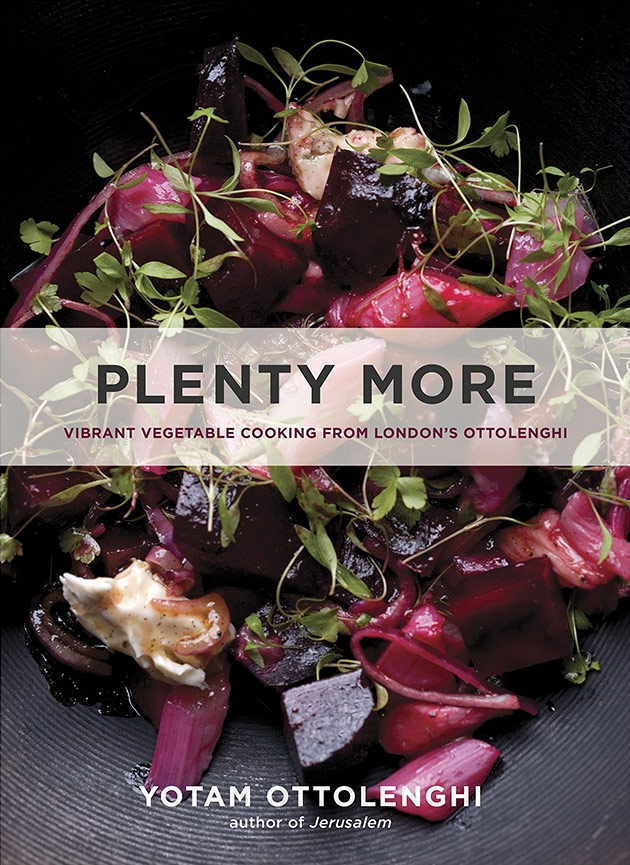
If you’re at all interested in cooking at home, you’ve likely got one of Yotam Ottolenghi’s cookbooks on your shelf: Jerusalem, Plenty, and Ottolenghi. I don’t cook much myself, but from everything I’ve heard from friends, this guy is a wizard with vegetables. Now Ottolenghi is out with a new cookbook: Plenty More.
Yotam Ottolenghi is one of the world’s most beloved culinary talents. In this follow-up to his bestselling Plenty, he continues to explore the diverse realm of vegetarian food with a wholly original approach. Organized by cooking method, more than 150 dazzling recipes emphasize spices, seasonality, and bold flavors. From inspired salads to hearty main dishes and luscious desserts, Plenty More is a must-have for vegetarians and omnivores alike. This visually stunning collection will change the way you cook and eat vegetables.
As a writer, designer, and, hell, as a human being, I value simplicity over most other considerations. But I also have a soft spot for dense hyper-detailed illustrations in the style of Mattias Adolfsson.

Many more examples of Adolfsson’s work is on Flickr. Reminds me of a pair of books I love reading with the kids: Mark Alan Stamaty’s Who Needs Donuts? and Cars and Trucks and Things That Go by Richard Scarry. The illustrations in these books are nearly infinite; the kids and I have read Cars and Trucks probably more than 70 times and almost every time through, we find something new.
After writing Design is a Job and noticing no one had written a book for clients who hired designers, Mike Monteiro of Mule Design decided to write one: You’re My Favorite Client.
Whether you’re a designer or not, you make design decisions every day.
Successful design projects require equal participation from both the client and the design team. Yet, for most people who buy design, the process remains a mystery.
In his follow-up to Design Is a Job, Mike Monteiro demystifies the design process and helps you prepare for your role. Ensure you’re asking the right questions, giving effective feedback, and hiring designers who will challenge you to make your product the best it can be.
Monteiro recently wrote 13 Ways Designers Screw Up Client Presentations and gave an interview to fellow designer Khoi Vinh.
I’ve been doing the primary research for this book for 20 years. I deal with clients every day and I see what works and doesn’t work and I’ve screwed up more times than I’d like to think about. But every lesson in that book is field tested. This book has zero percent theory in it. It was written on a factory floor.
I somehow didn’t know or forgot that PT Anderson was doing a movie based on Thomas Pynchon’s Inherent Vice. It turns out he totally is and here’s the first trailer:
That looks entirely goofy and good.
Mad food scientist Dave Arnold, lately of high-tech NYC bar Booker & Dax, is coming out with a book called Liquid Intelligence: The Art and Science of the Perfect Cocktail.
Years of rigorous experimentation and study — botched attempts and inspired solutions — have yielded the recipes and techniques found in these pages. Featuring more than 120 recipes and nearly 450 color photographs, Liquid Intelligence begins with the simple — how ice forms and how to make crystal-clear cubes in your own freezer — and then progresses into advanced techniques like clarifying cloudy lime juice with enzymes, nitro-muddling fresh basil to prevent browning, and infusing vodka with coffee, orange, or peppercorns.
Practical tips for preparing drinks by the pitcher, making homemade sodas, and building a specialized bar in your own home are exactly what drink enthusiasts need to know. For devotees seeking the cutting edge, chapters on liquid nitrogen, chitosan/gellan washing, and the applications of a centrifuge expand the boundaries of traditional cocktail craft.
I don’t know how many cocktail books the world can handle but even with The Bar Book, Death & Co., The PDT Cocktail Book, and Bitters, my personal library still has space on the shelf for more. (via @kathrynyu)
Rose Callahan photographs gentlemen with “exceptional personal style” for her blog, The Dandy Portraits.


She’s collected some of her best shots into a book, I Am Dandy: The Return of the Elegant Gentleman. See also the great dude battles of the 1880s. (via slate)
One of the last interviews David Foster Wallace gave was with Bryan Garner, a lawyer and lexicographer who became friendly with Wallace due to their mutual love of language. That hour-long interview is reproduced in Quack This Way: David Foster Wallace & Bryan A. Garner Talk Language and Writing.
David Foster Wallace was at the center of late-20th-century American literature, Bryan A. Garner at that of legal scholarship and lexicography. It was language that drew them together. The wide-ranging interview reproduced here memorializes 67 minutes of their second and final evening together, in February 2006. It was DFW’s last long interview, and the only one devoted exclusively to language and writing.
It was Wallace’s piece featuring Garner in Harper’s, Tense Present, that cemented him as a favorite writer of mine, even before I tackled Infinite Jest. Wallace later expanded the essay to 62 pages in Consider the Lobster and Other Essays.

TBD Catalog is a catalog from the near future, filled with imagined goods you might see in a SkyMall or IKEA catalog in 2024. Or as they put it, “the catalog of the near future’s normal ordinary everyday”.
This is not your near future of superlative Silicon Valley exuberance where you happily 3D-print a perfect set of lease-licensed Opinel steak knives or blissfully commute to work in your fascistically sleek Google-powered, chem-battery fueled autonomous vehicles. Nor is this the abysmal near future where you huddle in the smoldering foxholes of apocalyptic ruin. TBD Catalog runs through the middle. It is neither extreme. It is a design fiction about a normal, ordinary everyday near future. TBD Catalog is a design fiction because it makes implications without making predictions. TBD Catalog is a design fiction because it sparks conversations about the near future. It serves to design-develop prototypes and shape embryonic concepts in order to discard them, make them better, reconsider what we may take for granted.
From the brains of Bruce Sterling, James Bridle, Aaron Straup Cope, and a dozen others, you can order yours here. And holy cow, I’m getting one of these Bounty Hunter Coaches Jackets too. (Looking good, @darthjulian)
Alex Wellerstein took all of the badge photos of the people who worked on the atomic bomb project during World War II at Los Alamos and made a huge image out of them.
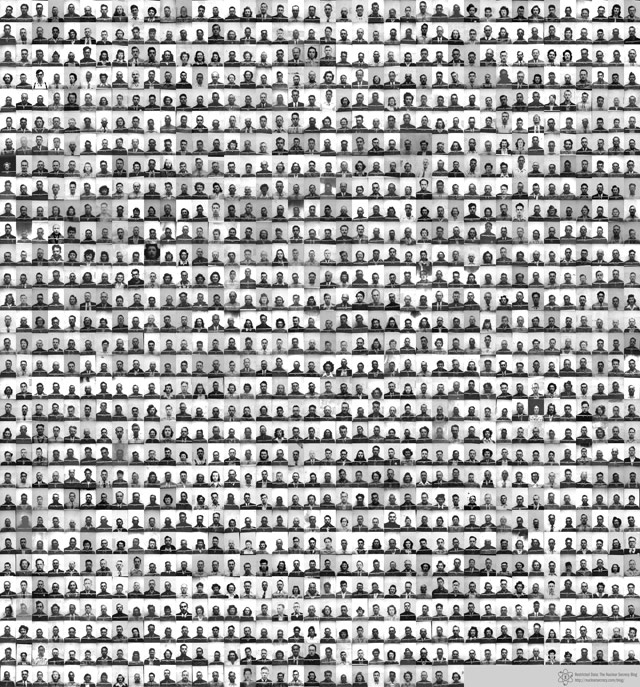
I just finished reading Genius, James Gleick’s excellent biography of Richard Feynman. Here’s Feynman (left) and his friend Klaus Fuchs, whose car he used to borrow on the weekends to visit his ailing wife in Albuquerque.
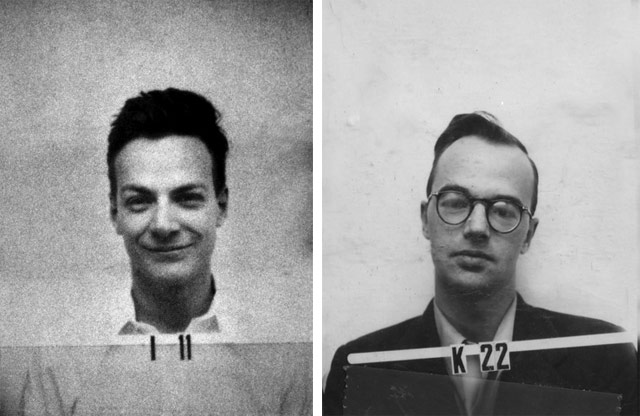
After the war, Fuchs was revealed to be a Soviet spy. If you’re at all interested in the Manhattan Project and the espionage surrounding it and somehow have not read Richard Rhodes’ The Making of the Atomic Bomb and Dark Sun, do so now…they are two of my all-time favorite books. (via greg.org)

From the author of the bestselling children’s book Go the Fuck to Sleep comes a sequel of sorts: You Have to Fucking Eat.
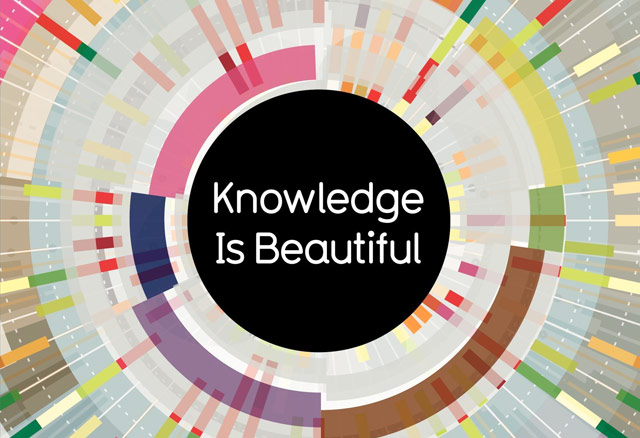
David McCandless has been highlighting good information design for years on Information Is Beautiful. The site spawned a book of the same name in 2009. Now McCandless is back with a new book, Knowledge Is Beautiful.
Every day, every hour, every minute we are bombarded with information, from television, from newspapers, from the Internet, we’re steeped in it. We need a way to relate to it. Enter David McCandless and his stunning infographics, simple, elegant ways to interact with information too complex or abstract to grasp any way but visually. McCandless creates visually stunning displays that blend the facts with their connections, contexts, and relationships, making information meaningful, entertaining, and beautiful. And his genius is as much in finding fresh ways to provocatively combine datasets as it is in finding new ways to show the results.
Here’s some more information about the book.

When Russian author Leo Tolstoy was in his 60s, he was asked to list the books which influenced him the most in his career. He responded by grouping the books into three main categories by level of impact: great, v. great, and enormous. Some of his picks:
Matthew’s Gospel: Sermon on the Mount - Enormous
Dickens’ David Copperfield - Enormous
Victor Hugo. Les Misérables - Enormous
Pushkin’s Yevgeny Onegin - V. great
George Eliot. Novels - Great
The NY Times reprinted the list in 1978; here’s the original listing.

Amazon updated their line of Kindles and tablets and the Kindle Voyage looks like great top-of-the-line dedicated ereader. The Verge loves it. I’m still rocking a third-generation Kindle and have been pondering an upgrade to a Paperwhite, but the Voyage is very tempting.
From Hilary Mantel’s forthcoming collection, The Assassination of Margaret Thatcher, an excerpt of the title story in the NY Times Sunday Book Review.
I said, “It’s the fake femininity I can’t stand, and the counterfeit voice. The way she boasts about her dad the grocer and what he taught her, but you know she would change it all if she could, and be born to rich people. It’s the way she loves the rich, the way she worships them. It’s her philistinism, her ignorance, and the way she revels in her ignorance. It’s her lack of pity. Why does she need an eye operation? Is it because she can’t cry?”
When the telephone rang, it made us both jump. I broke off what I was saying. “Answer that,” he said. “It will be for me.”
And this line!
She lives on the fumes of whiskey and the iron in the blood of her prey.
I love Hilary Mantel. Instant pre-order. (via @TomJunod)
Update: A member of Parliment’s House of Lords is calling for Hilary Mantel to be investigated by the police for this story.
“If somebody admits they want to assassinate somebody, surely the police should investigate,” Lord Timothy Bell, a friend and former PR adviser to Thatcher, told the Sunday Times. “This is in unquestionably bad taste.”
The Guardian took Bell to task for his own taste:
Let us deal first with taste. This man’s client-list presently glitters with Rolf Harris and Cuadrilla, the UK fracking company. He has previously managed the reputations of General Pinochet and Asma al-Assad, wife of the Syrian president. “I’m not concerned with taste,” said Mantel in my interview with her. Apparently neither is Lord Bell.
English PEN released a statement in support of Mantel:
Lord Bell’s call for the police to investigate Mantel for writing a work of fiction is disproportionate and wholly inappropriate. The fact that Ms Mantel’s story has caused offence is not a matter for the police: authors are free to shock or challenge their readership by depicting extraordinary events or extreme acts.
‘If depicting a murder in literature were equivalent to inciting murder, then Lord Bell’s colleagues Lord Dobbs, Baroness James and Baroness Rendell would all need to be investigated by the police too,’ said Robert Sharp, Head of Campaigns at English PEN. ‘It is most disturbing when politicians and commentators in a democracy start calling for censorship on the grounds of offence or bad taste. Not only does it undermine the right to freedom of expression in the UK, it sends a very poor signal to politicians in authoritarian regimes who sue, threaten and sometimes kill writers and journalists for satirising or criticising the political class.’
Even if it’s fake it’s real?
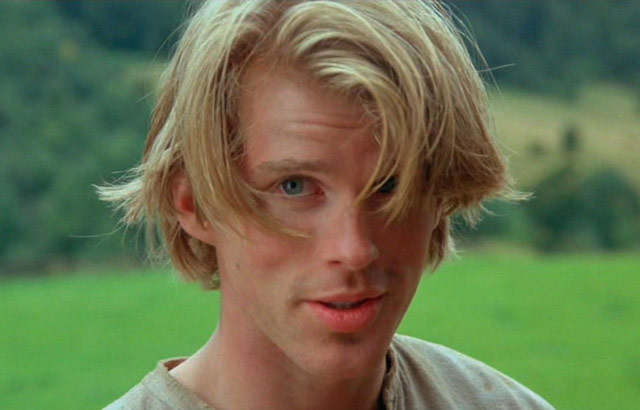
Actor Cary Elwes (Westley, The Dread Pirate Roberts) has written a book about the making of the Princess Bride, As You Wish: Inconceivable Tales from the Making of The Princess Bride.
From actor Cary Elwes, who played the iconic role of Westley in The Princess Bride, comes a first-person account and behind-the-scenes look at the making of the cult classic film filled with never-before-told stories, exclusive photographs, and interviews with costars Robin Wright, Wallace Shawn, Billy Crystal, Christopher Guest, and Mandy Patinkin, as well as author and screenwriter William Goldman, producer Norman Lear, and director Rob Reiner.
The Princess Bride isn’t currently streaming on Netflix, but you can rent it from Amazon.
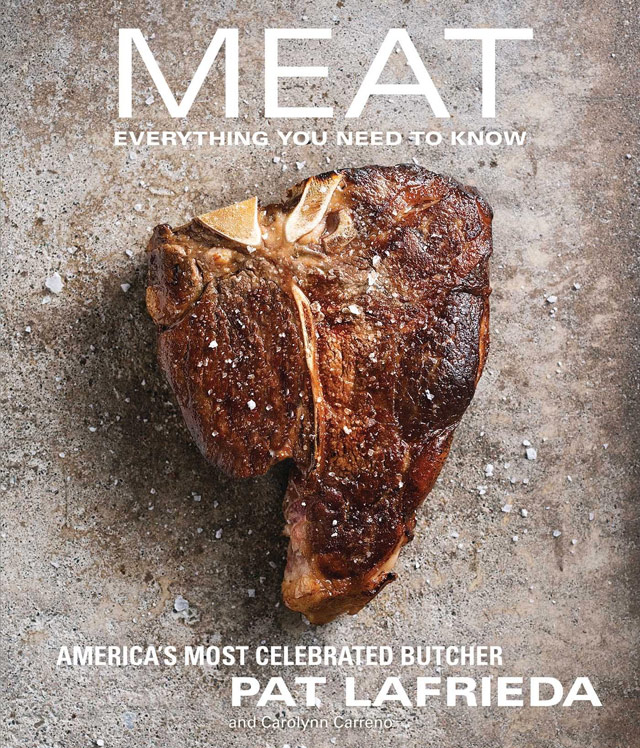
Whoa hey, super-butcher Pat LaFrieda has a cookbook out, Meat: Everything You Need to Know.
No one understands meat’s seductive hold on our palates better than America’s premier butcher, Pat LaFrieda. In Meat: Everything You Need to Know, he passionately explains the best and most flavorful cuts to purchase (some of them surprisingly inexpensive or unknown) and shares delicious recipes and meticulous techniques, all with the knowledge that comes from a fourth generation butcher. If you have ever wondered what makes the meat in America’s finest restaurants so delectable, LaFrieda — the butcher to the country’s greatest chefs — has the answers, and the philosophy behind it.
Paired up with Tartine Bread, all we need now is some emulsifying genius to hit us with Mayonnaise cookbook and we’ll be all set in sandwich-land.
Walter Isaacson has written books on Albert Einstein, Benjamin Franklin, and Steve Jobs. His newest book, The Innovators, is due out in early October and focuses on the people who invented computing and the Internet.
In his masterly saga, Isaacson begins with Ada Lovelace, Lord Byron’s daughter, who pioneered computer programming in the 1840s. He explores the fascinating personalities that created our current digital revolution, such as Vannevar Bush, Alan Turing, John von Neumann, J.C.R. Licklider, Doug Engelbart, Robert Noyce, Bill Gates, Steve Wozniak, Steve Jobs, Tim Berners-Lee, and Larry Page.
This is the story of how their minds worked and what made them so inventive. It’s also a narrative of how their ability to collaborate and master the art of teamwork made them even more creative.
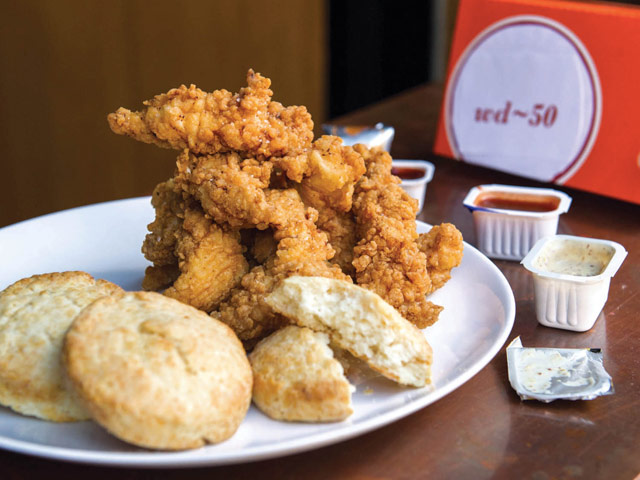
Well, well. For a cookbook called Fried & True: More than 50 Recipes for America’s Best Fried Chicken and Sides, food genius Wylie Dufresne recreated the recipes for Popeye’s chicken and biscuits.
The tenders first get an overnight soak in buttermilk and hot sauce that makes them juicy and, um, tender. To nail the perfectly seasoned crust, he eventually landed on a breading that includes a packet of onion soup and a hefty dose of McCormick’s Italian Herb Spaghetti Sauce Seasoning Mix. (If this makes you cringe, remember who we’re talking about here, and trust.) Cornstarch, potato starch and baking soda added to the self-rising flour mixture ensure the signature craggy texture and exceptional crunch. Finally, after much experimentation to find the perfect frying temperature, he settled on a relatively low 300°, which renders the crust a deep golden-brown and keeps the lean meat moist.
Better than the original, says Serious Eats’ Maggie Mariolis. Dang.
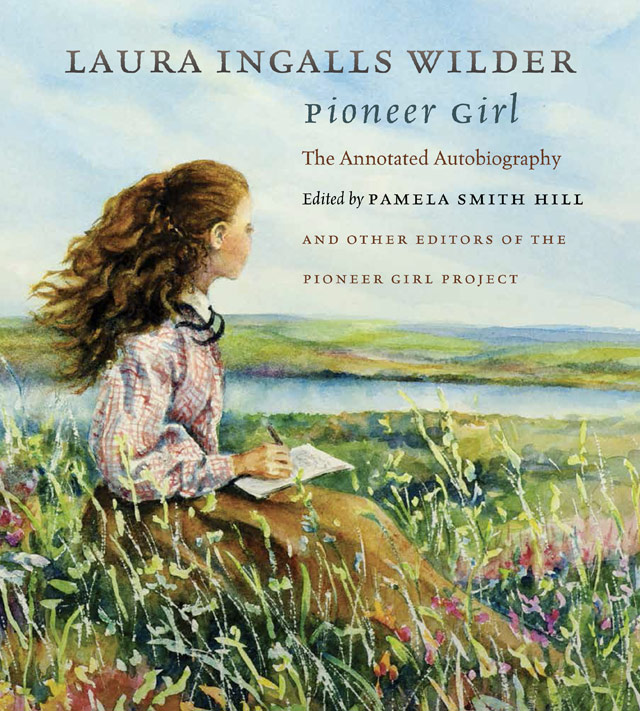
Laura Ingalls Wilder wrote her autobiography, Pioneer Girl, in the early 1930s. The book was deemed unsuitable for publication, but Wilder reworked her story into the successful Little House on the Prairie series for children.
Now the South Dakota Historical Society is publishing an annotated version of Pioneer Girl, which includes stories from Wilder’s childhood that didn’t make it into the kids’ books. And for good reason.
It contains stories omitted from her novels, tales that Wilder herself felt “would not be appropriate” for children, such as her family’s sojourn in the town of Burr Oak, where she once saw a man became so drunk that, when he lit a cigar, the whisky fumes on his breath ignited and killed him instantly. In another recollection, a shopkeeper drags his wife around by her hair, pours kerosene on the floor of his house, and sets their bedroom on fire.
Wilder’s memoir also paints a different picture of her father, Charles Ingalls, known in the novels as Pa. Although the real man’s character is essentially the same as the version in the novels - affectionate, musical and restless to move on through America’s frontier - he is, said the book’s publisher, the South Dakota Historical Society Press, clearly “romanticised and idealised”. In Wilder’s autobiography, he is described sneaking his family out of town in the middle of the night after failing to negotiate the rent with the landlord, justifying the flit by calling the man a “rich old skinflint”.
Earlier this year, there was an open casting call for the role of Laura in a new movie version of Little House on the Prairie. Maybe the drunken self-immolation will make it into this one!
Update: Pioneer Girl has become an unlikely bestseller. The small press that published the book is doing a fifth printing and bookstores online and off can’t keep it in stock.
That a hardcover book of this heft and complexity — in addition to the side notes, there are scores of maps, illustrations and photographs — has been such a hit has surprised everyone, including the publisher. The South Dakota Historical Society Press is a seven-person operation based in Pierre. In the five months since the book’s release, it has been trying frantically to print more copies to keep up with demand (the first printing of 15,000 copies sold out in just a couple of weeks). “When people have to wait, they want it more,” says Nancy Tystad Koupal, director of the press.
The Guardian has published a lost chapter of Roald Dahl’s Charlie and the Chocolate Factory, which was cut from the book early on.
“I wonder how Augustus Pottle and Miranda Grope are feeling now?” Charlie Bucket asked his mother.
“Not too cocky, I shouldn’t think” Mrs Bucket answered. “Here - hold on to my hand, will you, darling. That’s right. Hold on tight and try not to let go. And don’t you go doing anything silly in here, either, you understand, or you might get sucked up into one of those dreadful pipes yourself, or something even worse maybe. Who knows?”
There’s not much to the chapter…it seems as though for the finished product Dahl pared down the number of children from ten to four and fleshed out each of their stories more. Here’s more on the lost chapter and early drafts of the book. (via @DavidGrann)
When he was 20, Christopher Knight walked into the woods of Maine and didn’t speak to another soul (save a quick “hi” to a passing hiker) for 27 years, during which he lived not off the land but off the propane tanks and freezers of his neighbors.
He started to speak. A little. When Perkins-Vance asked why he didn’t want to answer any questions, he said he was ashamed. He spoke haltingly, uncertainly; the connection between his mind and his mouth seemed to have atrophied from disuse. But over the next couple of hours, he gradually opened up.
His name, he revealed, was Christopher Thomas Knight. Born on December 7, 1965. He said he had no address, no vehicle, did not file a tax return, and did not receive mail. He said he lived in the woods.
“For how long?” wondered Perkins-Vance.
Knight thought for a bit, then asked when the Chernobyl nuclear-plant disaster occurred. He had long ago lost the habit of marking time in months or years; this was just a news event he happened to remember. The nuclear meltdown took place in 1986, the same year, Knight said, he went to live in the woods. He was 20 years old at the time, not long out of high school. He was now 47, a middle-aged man.
Make sure you read until the end. This isn’t a just-the-facts-ma’am piece on some hermit; it turns out that someone who has spent almost three decades alone has something insightful to say about being human.
Update: The author of the GQ piece is coming out with a book in March about Knight called The Stranger in the Woods: The Extraordinary Story of the Last True Hermit.
Based on extensive interviews with Knight himself, this is a vividly detailed account of his secluded life — why did he leave? what did he learn? — as well as the challenges he has faced since returning to the world. It is a gripping story of survival that asks fundamental questions about solitude, community, and what makes a good life, and a deeply moving portrait of a man who was determined to live his own way, and succeeded.
Surgeon and New Yorker writer Atul Gawande has a new book about death coming out in October called Being Mortal.
Medicine has triumphed in modern times, transforming birth, injury, and infectious disease from harrowing to manageable. But in the inevitable condition of aging and death, the goals of medicine seem too frequently to run counter to the interest of the human spirit. Nursing homes, preoccupied with safety, pin patients into railed beds and wheelchairs. Hospitals isolate the dying, checking for vital signs long after the goals of cure have become moot. Doctors, committed to extending life, continue to carry out devastating procedures that in the end extend suffering.
Gawande, a practicing surgeon, addresses his profession’s ultimate limitation, arguing that quality of life is the desired goal for patients and families. Gawande offers examples of freer, more socially fulfilling models for assisting the infirm and dependent elderly, and he explores the varieties of hospice care to demonstrate that a person’s last weeks or months may be rich and dignified.
This piece Gawande wrote for the New Yorker in 2010 was probably the genesis of the book. I maintain a very short list of topics I’d like to write books about and death is one of them. Not from a macabre Vincent Price / Tim Burton perspective…more like this stuff. Dying is something that everyone has to deal with many times during the course of their life and few seem to have a handle on how to deal with it. That’s fascinating. Can’t wait to read Gawande’s book.
When Alex Belth was 25 years old, he worked with Joel and Ethan Coen on The Big Lebowski, first as a personal assistant and then as an assistant editor. He recently published a short Kindle book about the experience.
The Dudes Abide is the first behind-the-scenes account of the making of a Coen Brothers movie, and offers an intimate, first-hand narrative of the making of The Big Lebowski — including never-before-revealed details about the making of the film, and insight into the inner workings of the Coen Brothers’ genius.
An excerpt of the book was published on Deadspin.
Joel told Goodman about re-recording dialogue for the profanity-free television version of Fargo. They rewrote the line, “I’m fucking hungry now” to “I’m full of hungry now.”
“Why didn’t we write it like that originally?” said Joel. “It’s funnier.”
Goodman said, “Who else is coming on this show?” (In Los Angeles, movie people call a movie a “show.”)
There was Steve Buscemi as Donny, Julianne Moore as Maude, Jon Polito as Da Fino.
Joel said, “Our friend Luis, who was an assistant film editor on Hudsucker, will be playing the enraged Mexican.”
“Yeah, you’ll like Luis,” Ethan said in a creaky voice. “He makes a big statement.”
“Turturro is coming in to play the pederast,” Joel said. “He said he’d do his best F. Murray Abraham.”
(thx, brad)
For the New York Review of Books, Gordon Wood reviews Our Declaration: A Reading of the Declaration of Independence in Defense of Equality by Danielle Allen, a professor at the Institute for Advanced Study. Any review that starts “This is a strange and remarkable book” is worth paying attention to.
This is a strange and remarkable book. There must be dozens of books on the Declaration of Independence written from every conceivable point of view — historical, political, theoretical, philosophical, and textual — but no one has ever written a book on the Declaration quite like this one. If we read the Declaration of Independence slowly and carefully, Danielle Allen believes, then the document can become a basic primer for our democracy. It can be something that all of us — not just scholars and educated elites but common ordinary people — can participate in, and should participate in if we want to be good democratic citizens.
If the continent of Westeros from Game of Thrones had rail service, this is what the transit map might look like. Here’s the King’s Landing transport hub:

The maps are the work of designer Michael Tyznik and are available as prints: Westeros and The Known World.

From PA Press, the latest book in their Words of Wisdom series, The Chef Says. The book features quotes about food and cooking from the likes of Escoffier, April Bloomfield, Julia Child, and Grant Achatz.
Newer posts
Older posts























Stay Connected